
I don’t know if it’s just me, but the longer our quarantine lasts, the faster the days seem to slip right past us. I would’ve thought it’d be the opposite, with the days dragging by, but I find myself going from my breakfast to the computer to the garden and then I look up and the day’s already over. I’ve started accidentally skipping lunch (and I am a HUGE lunch person) just because I still think it’s noon when it’s already 3 o’clock. I also contribute this to the extra meal prep that my open schedule has been able to accommodate, which has consisted of me making all the more hands-on + time-consuming recipes that I’ve always wanted to make, but haven’t had the time for. And this list of exquisite dishes includes egg yolk ravioli, more traditionally known as Uova da Raviolo in Italy.
 I first heard about uova da raviolo from my friend Shauna, we were sharing cocktails after she’d just returned from her first trip to Europe, which consisted of visiting small farms throughout central Italy. She mentioned having a giant egg yolk ravioli, and I immediately asked her to describe it in minute detail. I learned that it’s a traditional Italian dish that consists of a single perfect extra-large ravioli, with an egg yolk and ricotta tucked away inside. Sometimes fresh herbs are incorporated, as well. It is always made fresh, and is cooked only briefly, because the yolk should stay wet and slowly ooze out of the cooked pasta at the first cut of the knife.
I first heard about uova da raviolo from my friend Shauna, we were sharing cocktails after she’d just returned from her first trip to Europe, which consisted of visiting small farms throughout central Italy. She mentioned having a giant egg yolk ravioli, and I immediately asked her to describe it in minute detail. I learned that it’s a traditional Italian dish that consists of a single perfect extra-large ravioli, with an egg yolk and ricotta tucked away inside. Sometimes fresh herbs are incorporated, as well. It is always made fresh, and is cooked only briefly, because the yolk should stay wet and slowly ooze out of the cooked pasta at the first cut of the knife.
 It sounded insane in the best possible way, and I knew I had to try making it at home. I did some recipe testing and have the goodness below to share with you. I basically made an herby ricotta filling to go with the egg yolk, and a delicious lemon pesto to serve alongside the egg yolk ravioli as a bright and tart contrast to the rich creamy filling. The end result was a dish so utterly full of flavor that I don’t know how it all fit onto one 8-inch plate. I do have some general tips, though, that will make it easier + save resources, so make sure to read through them below. Happy cooking!
It sounded insane in the best possible way, and I knew I had to try making it at home. I did some recipe testing and have the goodness below to share with you. I basically made an herby ricotta filling to go with the egg yolk, and a delicious lemon pesto to serve alongside the egg yolk ravioli as a bright and tart contrast to the rich creamy filling. The end result was a dish so utterly full of flavor that I don’t know how it all fit onto one 8-inch plate. I do have some general tips, though, that will make it easier + save resources, so make sure to read through them below. Happy cooking!
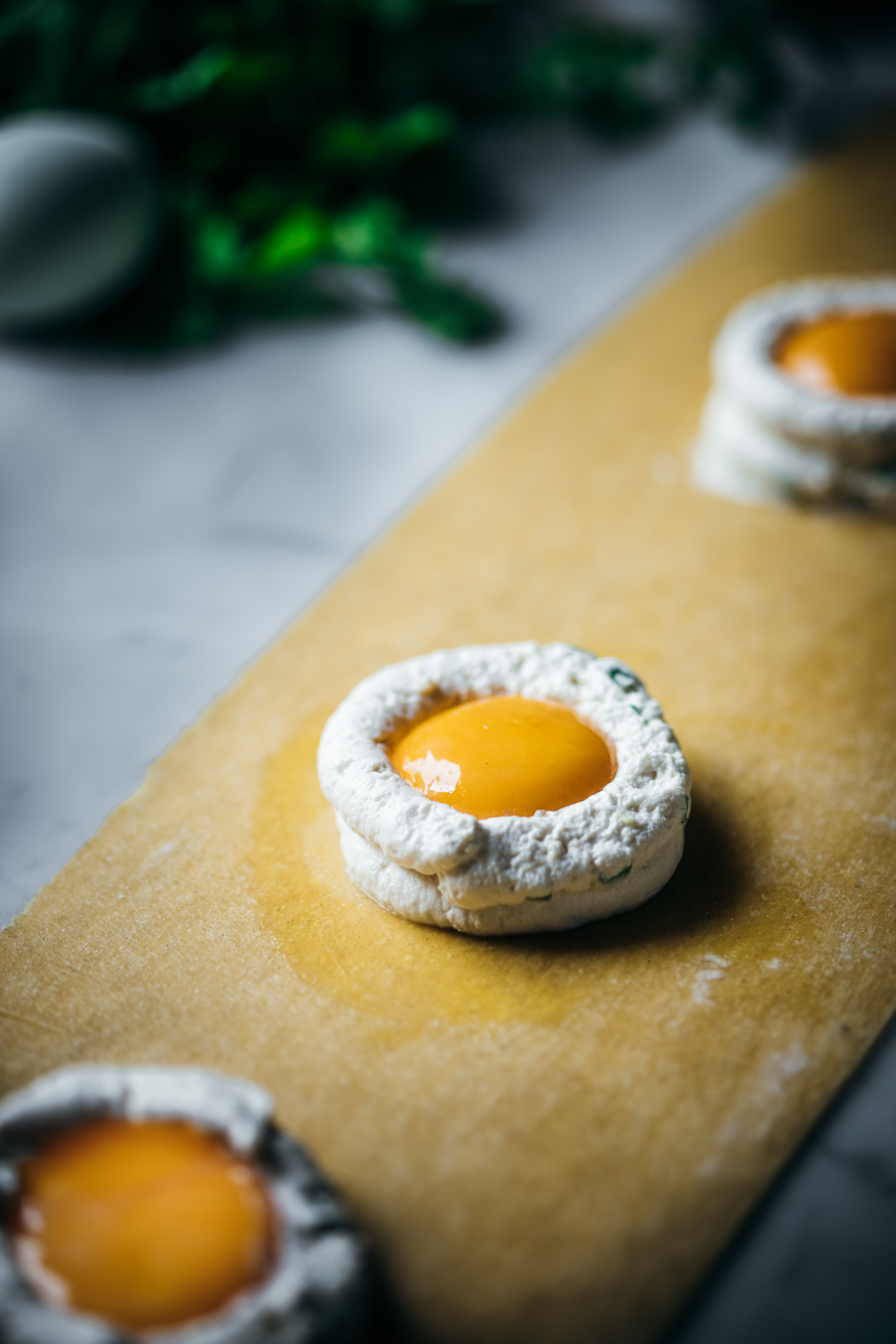 Tips for Making Egg Yolk Ravioli
Tips for Making Egg Yolk Ravioli
- Use a pasta press to flatten out the sheets of pasta dough. This is helpful for a couple reasons. First, it will make sure they’re uniform in thickness, which means they’ll cook evenly. Second, it saves you the time and intense effort of rolling out all that dough by hand.
- Use a pastry bag to pipe the ricotta filling onto the pasta dough. By piping the ricotta in a circle onto the pastry dough, you’re creating a structured wall of ricotta that will help contain and support the egg yolk when you spoon it onto the pasta. It’s much less messy and easier than using a spoon or spatula to try and make a well in the blob of ricotta you put on the pasta sheet.
- Enjoy it within 24 hours. These do not freeze well, since the yolk takes on a gelatinous texture when frozen (hence preventing that sexy goo-action). They will keep in the refrigerator for up to 24 hours, I recommend storing them in an airtight rectangular tupperware containers with a sheet of parchment paper that’s been brushed with oil between each egg yolk raviolo. If you store them any longer than 24 hours, the yolk dampens the dough and can cause it to stick to the parchment paper and tear.
- Take your time. This recipe is not for those in a hurry—it’s meant for a leisurely morning that sprawls into an afternoon. It’s also a great all-hands-on-deck activity, so if you’re quarantined with friends or family, it’s something fun and interesting (not to mention bonkers delicious) you can make altogether. On the flip-side, you can definitely make it solo, as well! It will just take a little more time/delicateness to seal up the second layer of dough on top of the filling.
- Save those egg whites! If you make the whole roughly 1-dozen batch, you’re going to have a LOT of egg whites left. Egg whites freeze really well, so feel free to pop them in ice cube trays so you have smaller portions at the ready. You can use them to whip up a stacked meringue, salt-baked fish, lavender lemon meringue pie, chocolate and goat cheese souffle, or a pavlova!
Egg Yolk Ravioli

Pasta Dough
- 1 3/4 cups plus 2 tablespoons flour
- 1/4 cup plus 2 tablespoons semolina flour
- 1/2 teaspoon kosher salt
- 1/2 teaspoon garlic powder
- 3 eggs
- 1 egg yolk
- 1 tablespoon extra-virgin olive oil
Lemon Pesto
- 1/4 cup fresh squeezed lemon juice
- 3 ounces coarsely chopped fresh basil leaves and stems
- 2 ounces coarsely chopped fresh parsley leaves and stems
- 2 cloves garlic (coarsely chopped)
- 2 teaspoons finely grated organic lemon zest
- 3 ounces shelled chopped walnuts
- 1 ounce shelled chopped hazelnuts
- 2 ounces grated Parmigiano-Reggiano cheese plus additional for garnish
- 1/2 teaspoon salt
- 1/2 cup plus 3 tablespoons extra virgin olive oil
Ricotta + Egg Yolk Filling
- 8 ounces ricotta cheese
- 3 tablespoons finely chopped fresh chives
- 2 tablespoons milk
- 2 teaspoons sherry vinegar
- 3/4 teaspoon kosher salt
- 12 individual egg yolks (still in their individual whole yolks (It helps to keep them in a flat casserole pan, storing them in a bowl puts too much pressure on the yolks at the bottom and makes them burst open))
For Serving (Optional)
- Finely grated lemon zest
- Finely grated parmesan
Lemon Pesto
- Pulse the lemon juice, herbs, garlic, and zest in a food processor until almost a paste, scraping down side of bowl as needed. Add the nuts, parmesan, and salt. Pulse until no whole nuts remain. With the motor running, add the olive oil in steady stream until well blended. Season with additional salt, if desired. Transfer to a jar, cover, and refrigerate.
Pasta Dough
- In a large bowl, mix together the flour, semolina, salt, and garlic powder. Turn the mixture onto a clean flat work surface.
- Make a large well in the middle of the flour pile and add the eggs, egg yolks, and oil. Using a fork, gently start to swirl together the eggs, yolks, and oil, slowly incorporating the flour into the wet ingredients and taking care not to break the flour wall holding in the liquid ingredients. Continue mixing until the center is thick enough that you can stir in the flour walls without the mixture spilling out everywhere.
-
Stir until the dough comes together enough that you can knead it. Knead the dough until it is very smooth and elastic, about 8 to 10 minutes. Separate the dough into 4 equal-sized portions. Form each one into a long rough oval shape, no thicker than 1/2 of an inch and no wider than 3 inches (they can be as long as needed). Seal them tightly with plastic wrap and refrigerate for 1 hour.
Ricotta + Egg Yolk Filling
- For the ricotta filling, mix together the ricotta, chives, milk, sherry vinegar, and salt in a medium bowl until combined. Fit a pastry bag with a large circle tip and fill it 2/3-full with the ricotta filling. Set it aside.
Assembly
- Clear a large clean surface to work on. Pass one oval of the dough through a pasta press at thickness level Pass it through again at thickness level Pass it through again at thickness level 3, and continuing until you’ve passed it through to thickness level 5, which is 1.5 mm thick. Repeat with all the ovals of pasta dough.
- Take one sheet of dough and lay it on a clean work surface. Measure the width of the sheet (it should be about 4 to 5 inches wide). Starting where the width becomes consistent (i.e. not at the ends of the sheet), use measuring tape or a ruler placed next to the sheet to make a small cut on the edge of the dough every 4 to 5 inches (i.e. the width of the sheet).
-
In the center between the markings, use the pastry bag to pipe a circle of ricotta filling that's about 2 inches in diameter. Use a spoon to gently transfer one of the egg yolks into the ricotta well. Use the pastry bag to pipe one more circle on top of the initial circle, thus walling-in the egg yolk. Repeat between every marking. Once you have all your filling placed, dip your finger (or use a pastry brush) in a glass of water and gently run it along the exposed pasta dough, re-dipping as-need to keep your finger lightly damp (this will help the dough seal). You don't want a lot of water on the dough, just a trace.
- Lay a second sheet of dough over the first (if you have an extra set of hands, this will make it easier). Using your fingertips, press very firmly around each mound of filling to seal it in, taking care not to accidentally push down on the filling (which can break the seal between the layers of dough). Then press outward toward edges of the dough, pushing out any air pockets. It’s very important to get any air out of the raviolis, otherwise it can cause the raviolo to burst when cooking.
-
For square ravioli, use a pizza cutter to cut the sheet across into individual raviolo. For round raviolo, you can use a large (4 to 5-inch circular cookie cutter.)
-
Repeat the above process with the remaining filling and dough until all the ravioli have been assembled.
-
The ravioli should be enjoyed within 24 hours. These do not freeze well, since the yolk takes on a gelatinous texture when frozen. They will keep in the refrigerator for up to 24 hours, I recommend storing them in airtight rectangular tupperware containers with a sheet of parchment paper that's been brushed with oil between each egg yolk raviolo (to prevent sticking). If you store them any longer than 24 hours, the yolk dampens the dough and makes it extra sticky, which can cause it to tear.
-
To prepare, bring a quart of water to a boil. Add 2 teaspoons of salt and stir to dissolve. Add 2 ravioli and cook 4 minutes for al dente and 5 minutes for a softer pasta, stirring once per minute to keep them from sticking to the bottom of the pot/each other.
-
Use a slotted or mesh spoon to remove the ravioli from the water and plate it. Garnish with 1/2 cup of the pesto, some grated lemon zest and parmesan, and enjoy!
-
Makes about 10 to 12 individual 4 to 5-inch square raviolis. About 2 ravioli is good for one person, depending on your appetite!
Disclaimer: Consuming raw or undercooked eggs can result in food born illness.
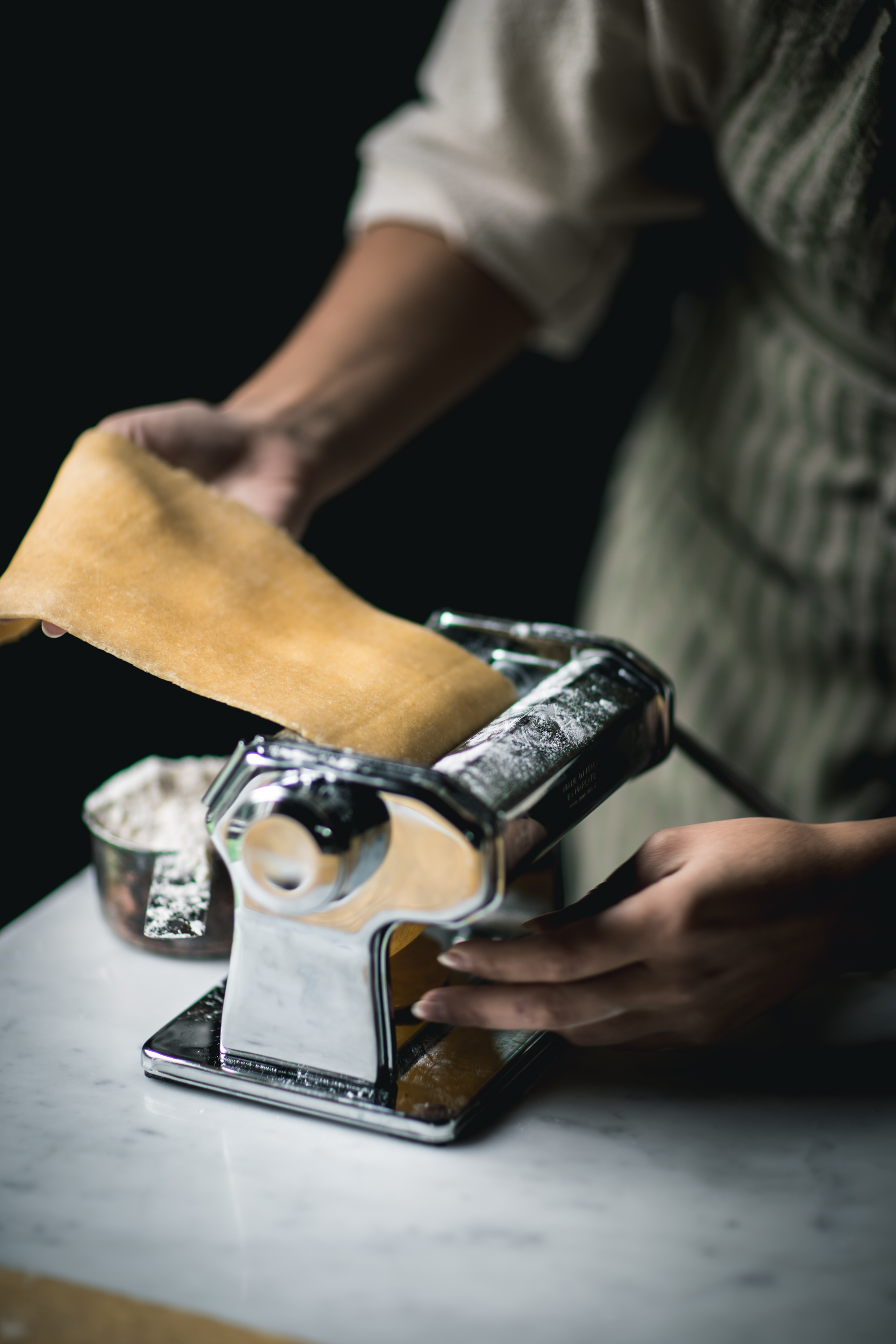




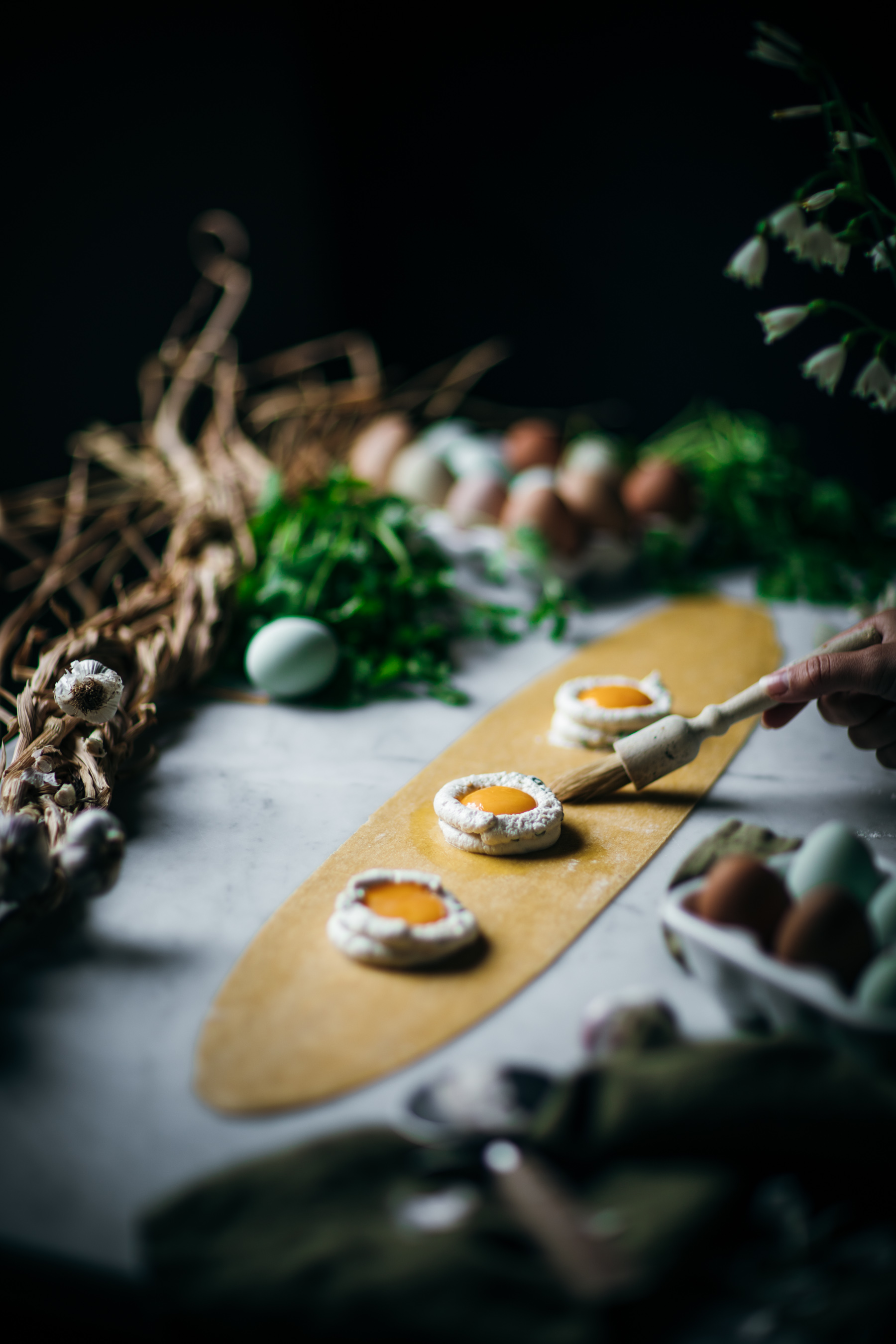

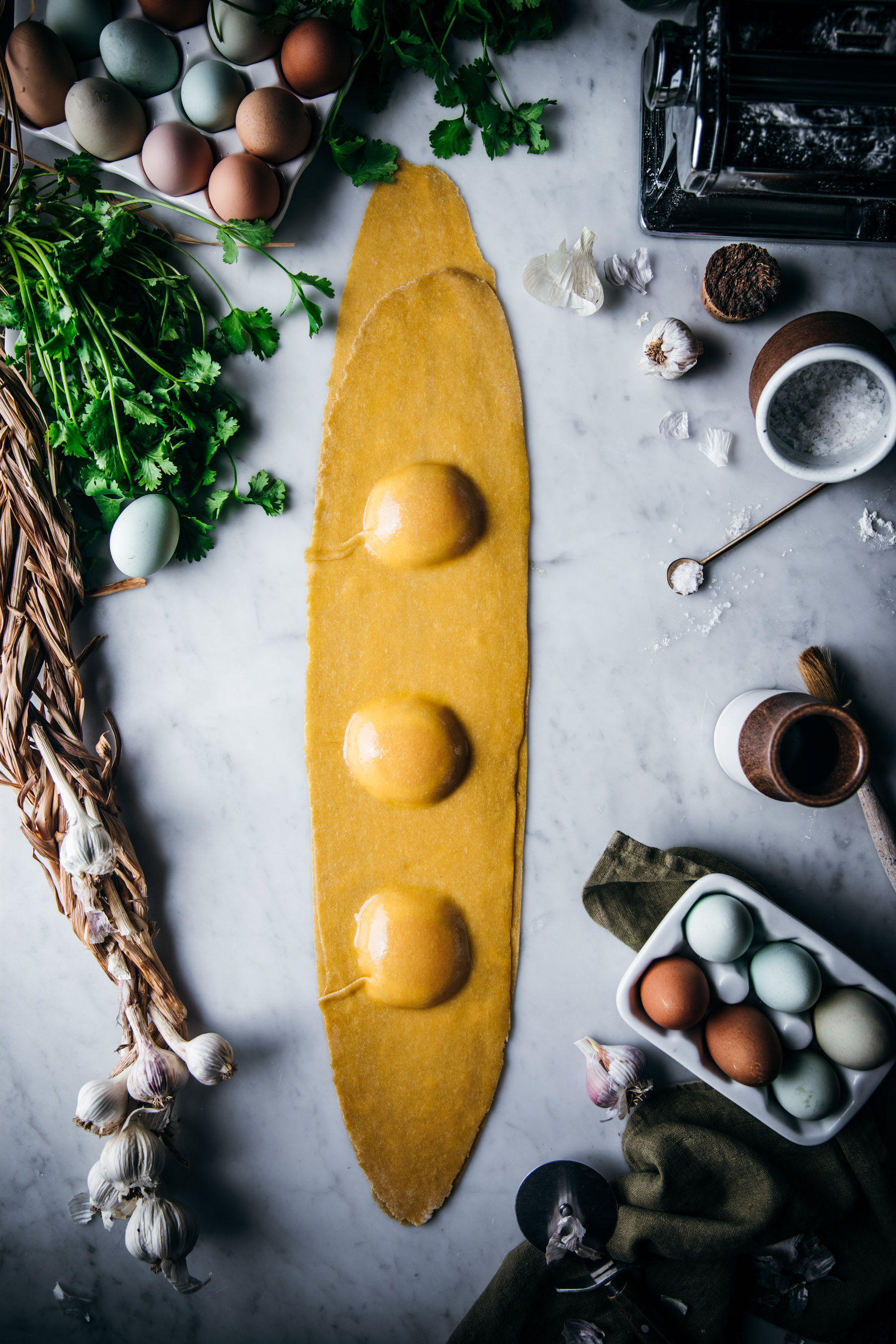


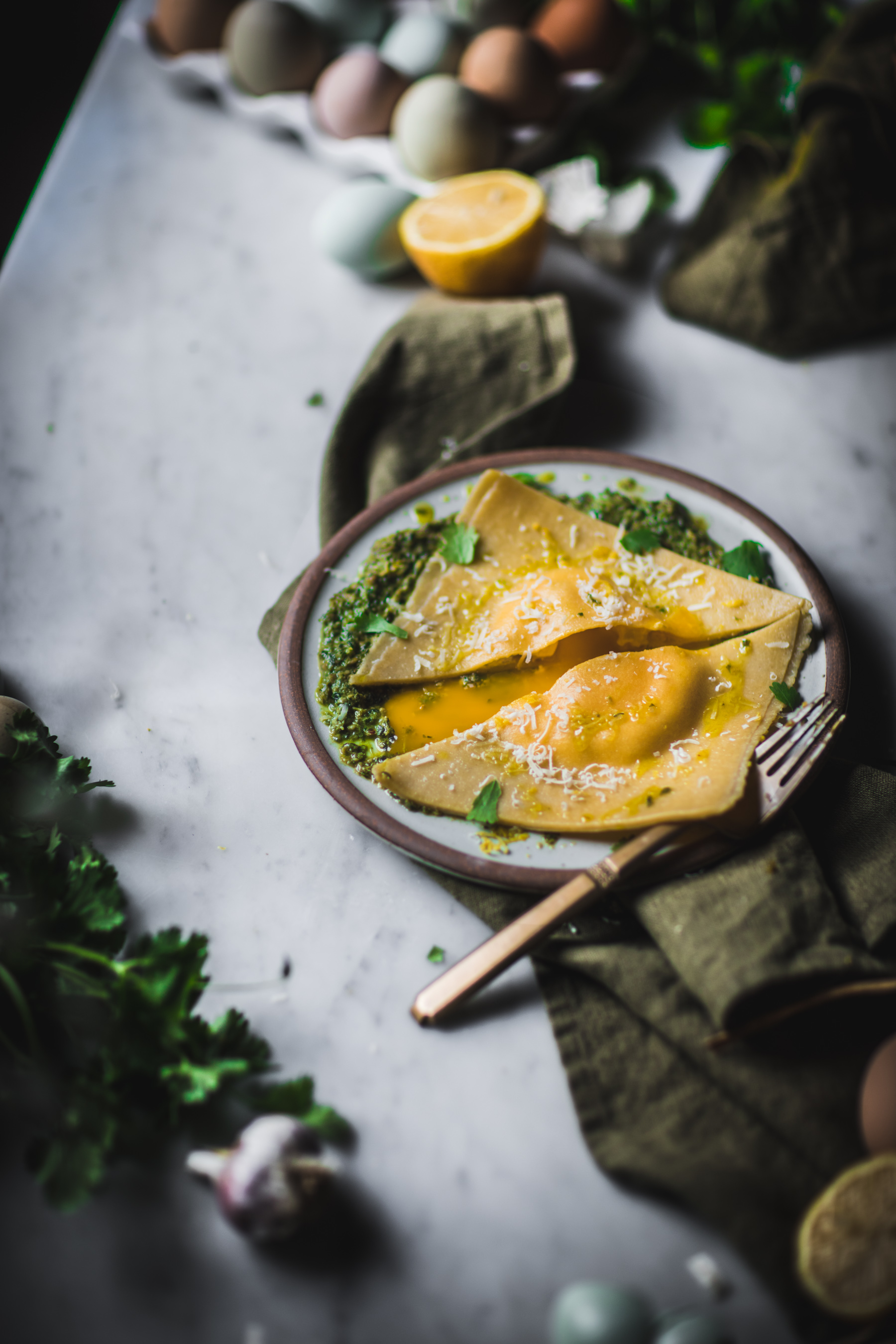




0 comments